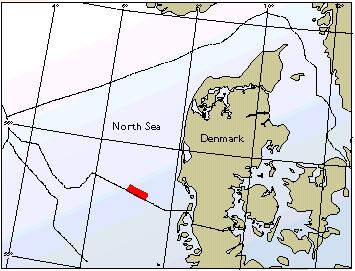|
Figure 1. Geographic setting of the
investigated area of extremely
well-preserved beam trawling
marks between 7o and 7o 15' E,
along the Danish and German
borderline.
The present investigation area (figure 1 )
located in the southern part of Danish
North Sea has by use of sidescan sonar
characterised the seabed sediment
distribution and registered any trawling
marks at the seabed. Throughout the
entire investigation area poorly preserved beam trawling marks generally are widely distributed. An exception, however, was found in an area near the German borderline of presumably coarse grained sediments with numerous extremely well-preserved beam trawling marks. Due to beam trawling the substrate appears locally to have entirely altered from presumably coarse grained sand and gravel to predominantly fine sand and/or coarse silt filling the trawl marks. Individual marks of trawl have a maximum width of about 12 m. Various individual areas where the original coarse substrate has now entirely been covered by fine sand are larger than 50.000 m2.
Fine sand /coarse silt normally is part of the mobile sediment fraction in the wave- and current exposed south-eastern North Sea. Bottom roughness contributes further to the turbulence of the bottom boundary layer and may normally prevent the deposition of fine grained sediment in the area dealt with.
Hence, deposition of fine-grained sediment in the study area normally may be prevented. The combined effect of a shallow scouring (< 10-20 cm) and smoothing from beam trawling can thus be concluded to have created conditions favouring fine sand/coarse silt sediment filling the trawl tracks as observed on the sonographs.
Some sidescan sonar recordings made to estimate the persistency of beam trawl marks on the sediment indicated that the sediment type is an important factor in determining the duration of visibility of the trawl marks (Fonteyne 1994). Long-term effects (> year) on the seabed from hydraulic dredging of Cardium Edule has been demonstrated by Runte ( 1991 ) during investigation in the German tidal flat areas. Comparing the sediment filling the dredging tracks with the sediment present outside these tracks the physical property characteristics of sediment has changed. This may imply that beam trawling also has a long-term effect on the seabed, as has been demonstrated above. In some areas this may have resulted in a definitive change of the substrate with all possible implications for the benthic community.
It is therefore strongly recommended to conduct repeated (yearly) sidescan sonar surveys and sediment sampling programmes in beam trawling areas for monitoring the extent of changes of the seabed sediment in order to implement these information in the future fishery policy.
Using the long-term experience in geological surface sediment mapping would be an effective way to point out the most sensitive areas to beam trawling.
References:
Fonteyne, R., 1994: Physical impact of a 4 m beam trawl. In: De Groot & Lindeboom (eds.) Environmental impact of bottom gears on the benthic fauna in relation to natural resources management and protection of the North Sea. NIOZ Rapport 1994 no. 11, 21-58.
Runte, K.-H., 1991: Sedimentologish-Morphodynamische Untersuchungen zu den Auswirkungen der Herzmuschelfischerei rnit Spüldredgen im Wattenmeer. Berichte Forschung- und Technologiezentrum Westküste d. Universitet Kiel, Busum. Nr.1,11-136.
Gislason, H., 1996: Fiskeriets miljøpåvirkning. In: Abstracts fra 9. danske havforskermøde 1996.
|
